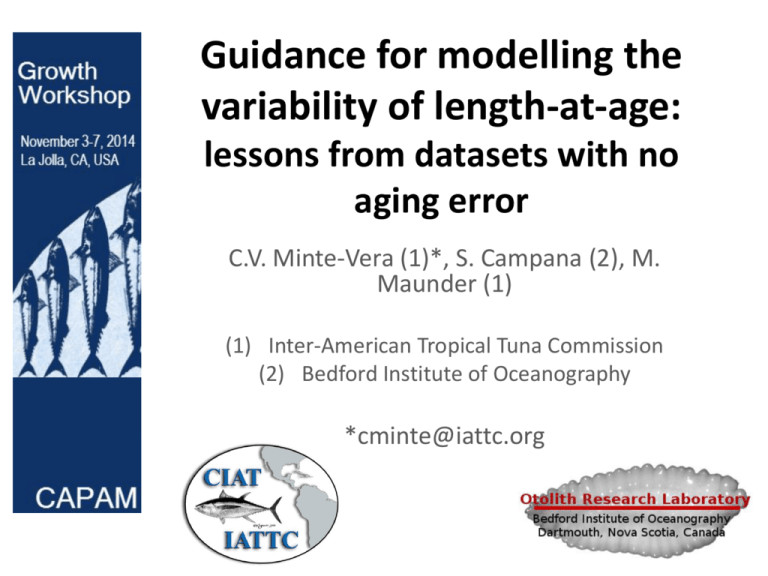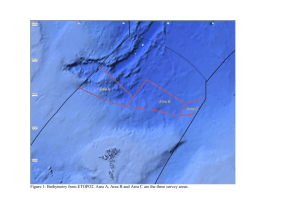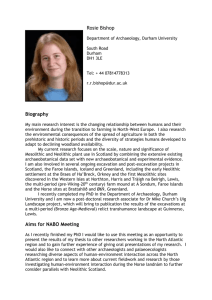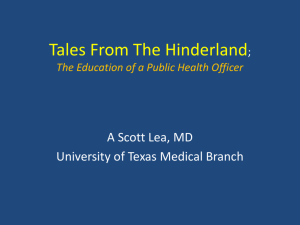Guidance for modelling the variability of length-at
advertisement

Guidance for modelling the variability of length-at-age: lessons from datasets with no aging error C.V. Minte-Vera (1)*, S. Campana (2), M. Maunder (1) (1) Inter-American Tropical Tuna Commission (2) Bedford Institute of Oceanography *cminte@iattc.org Outline of the Talk Introduction – The problem – Why it matters – What we will do to address it Methods – General overview Results – For each data set • General escription of data • By question: models and results Lessons learnt and future work Recommendations Introduction • Several stock assessments rely mainly on length frequencies, such as those for tropical tunas that have no or very limited age frequency data (or age conditional on length data). • Because of lack of information, assumptions about how the variability of length-at-age changes with age are adopted. Most likely the parameters are fixed are “reasonable” values. • The variability of length-at-age can highly influence the interpretation of the length-frequency information in the context of integrated analysis for stock assessment. • Potential effects on the magnitude of the estimated derived quantities (biomass, harvest rate) and on the management advice Introduction What assumption to choose? And why? for both the expected size at age and variability of size at age Introduction In this study we will address these questions by taking advantage of two rarely available data sets no (or minimal) ageing error • One data set with completely know age structure • One data set from a pristine long-lived lake population Specific questions to be addressed • What is the best model to describe the growth trajectory in for the fished and unfished groups? • What is the magnitude of variability of size at age of a cohort with other sources of variability controlled (birth date, aging error, sampling,…)? • How does it varies over size or age? • Does this depends on whether it was fished or not? Methods 1. What is the best summary statistics? Computed mean size at age , standard deviations and coefficient of variation of size at age and explore relationships. For continuous age data, break the distribution into intervals. 2. What is the best functional form? a. generalized logistic function, which can metamorphose into more than 10 growth functions (Von Bertalanffy, Richard, Gompetz, …). AIC. b. introduce a new growth function: linear-Von Bertalanffy, which is also fit to maturity data. 3. What is the best of size-at-age variability assumption? Four model: linear relationship between sd or CV as a function of either mean size at age or age (SS3 assumption) More details latter… Faroe Cod ICES Vb1b: Faroe Plateau ICES Vb2: Faroe Bank Faroe Cod • Enhancement program of the Faroese Fisheries Laboratory and the Aquaculture Research Station • Stock decline and fishery collapsed in 1990 • Fish caught at the two spawning grounds in 1994, held in captivity until matured • Eggs and larvae reared in tanks, separated by origin • With about 1 year old, tagged, released either to mesocosm or to the wild, after a couple of weeks of tagging • In mesocosm, mixed in three pens, with 50%fish of each stock , subsamples taken between January and April each year. • 8408 released to Faroe Plateau in 1995, recovered by fishes • (same for Faroe Bank, but very few recoveries) • 3500 fish from Faroe Plateau and 3000 from Faroe Bank help in mixed pens until the spring of 2000. In mesocosm, fish measured for the first time at 2 years old 100 Variability of 2 years-old length at age is similar for both stocks when reared in similar conditions 90 80 length (cm) 70 60 50 40 Faroe Plateau Mesocosm 30 Faroe Plateau Wild 20 Faroe Bank Mesocosm 10 Faroe Bank Wild 0 0 500 1000 1500 age (days) 2000 2500 The same variability of 2-year old fish that hatched in different days Hatching date 21/4/94 8 0 2 4 Frequency 6 8 23/4/94 6 0 2 4 Frequency 4 2 0 Frequency 6 8 22/4/94 50 55 60 65 70 75 80 50 55 60 65 70 75 80 50 55 60 65 70 75 80 y[x1 == x[i]] y[x1 == x[i]] y[x1 == x[i]] Length (cm) Faroe Bank fish Fish released in the wild (recovered by fishers) of about 2years old have similar variability of size at age than mesocosm fish 100 In mesocosm, the variability of size at age seems the same over ages 90 80 length (cm) 70 60 50 40 Faroe Plateau Mesocosm 30 Faroe Plateau Wild 20 Faroe Bank Mesocosm 10 Faroe Bank Wild 0 0 500 1000 1500 age (days) 2000 2500 100 Reared in the same conditions, fish from both stocks have similar growth patterns 90 80 length (cm) 70 60 50 40 Faroe Plateau Mesocosm 30 Faroe Plateau Wild 20 Faroe Bank Mesocosm 10 Faroe Bank Wild 0 0 500 1000 1500 age (days) 2000 2500 100 In the wild variability of size at age seems to decrease at older ages (fewer recoveries also) 90 80 length (cm) 70 60 50 40 Faroe Plateau Mesocosm 30 Faroe Plateau Wild 20 Faroe Bank Mesocosm 10 Faroe Bank Wild 0 0 500 1000 1500 age (days) 2000 2500 100 Growth rates seem different by area released 90 80 length (cm) 70 60 50 40 Faroe Plateau Mesocosm 30 Faroe Plateau Wild 20 Faroe Bank Mesocosm 10 Faroe Bank Wild 0 0 500 1000 1500 age (days) 2000 2500 100 Wild (fished) X Mesocosm (unfished) Apparently different growth pattern and variability of size at age 90 80 length (cm) 70 60 50 40 Faroe Plateau Mesocosm 30 Faroe Plateau Wild 20 Faroe Bank Mesocosm 10 Faroe Bank Wild 0 0 500 1000 1500 age (days) 2000 2500 Full data set 100 90 80 length (cm) 70 60 50 40 Faroe Plateau Mesocosm 30 Faroe Plateau Wild 20 Faroe Bank Mesocosm 10 Faroe Bank Wild 0 0 500 1000 1500 age (days) 2000 2500 Variability of size at age CV length at age CV length at age Wild Coefficient of Variation Standard Deviation (cm) Mesocosm 20 18 16 14 12 10 8 6 4 2 0 Mesocosm Average 8.16% 0 20 18 16 14 12 10 8 6 4 2 0 20 Wild 0 20 40 60 40 60 mean length at age (mm) Mean length at age (cm) 80 100 mean length at age (mm) 80 100 Variability of size at age 5.0 4.0 Faroe Bank / Mesocosm 3.0 2.0 Log. (Faroe Bank / Mesocosm) 1.0 0.0 0 500 1000 1500 2000 2500 age (days) 7.0 Wild 6.0 Faroe Bank / Wild 5.0 4.0 Faroe Plateau / Wild 3.0 2.0 Poly. (Faroe Plateau / Wild) 1.0 0.0 0 500 1000 1500 2000 2500 age (days) Age (days) CV length at age SD length at age (mm) SD length at age (mm) Standard Deviation (cm) Faroe Plateau / Mesocosm Coefficient of Variation Mesocosm 6.0 CV length at age 7.0 20 18 16 14 12 10 8 6 4 2 0 0 500 1000 1500 2000 2500 age (days) 20 18 16 14 12 10 8 6 4 2 0 0 500 1000 1500 age (days) 2000 2500 Growth pattern: Expected size at age Mesocosm (Unfished) 100 90 data Specialized VB Monomolecular growth Exponential Growth Richards Generalized VB Smith Blumberg Generic growth Second order exp polynomial Gompetz Generalized Gompetz Generalized Logistic Growth 80 length at age (cm) 70 60 50 40 30 20 10 0 0 500 1000 1500 age (days) Exponential Monomolecular Generalized Specialized Growth growth VB VB alpha 1 0 1.38 0.67 beta 1 1 1 0.33 gama 1 1 1 1 K 0.00 0.09 0.00 0.03 Linf 70.53 78.93 70.06 71.49 L0 11.35 0.00 15.68 0.98 sd 5.23 5.51 5.19 5.23 NLL 917 934 916.3616405 919 npar 4 4 5 4 AIC 1842.0 1875.8 1842.7 1845.5 delta AIC 4.68 38.47 5.40 8.14 Richards 1 2.953 1 0.00 69.66 17.60 5.19 916 5 1842.2 4.83 Smith 0.473 1.00 1.00 0.02 71.29 1.90 5.23 918 4 1844.7 7.42 2000 Blumberg -0.198 1 0.316 0.12 68.95 0.10 5.13 913 6 1837.7 0.35 2500 Generic growth 0.036 7.643 1.126 0.04 69.68 11.39 5.19 916 6 1844.2 6.87 Generalized Gompetz 1 0.0000001 0.603 25.54 69.00 14.21 5.16 914 5 1838.9 1.53 Gompetz 1 0.0000001 1 23302.81 71.21 4.38 5.23 918 4 1844.4 7.10 Second order exp polynomial 1 0.0000001 0.5 4.11 68.91 17.32 5.16 915 4 1837.3 0.00 Generalized Logistic Growth -0.098 0.176 0.314 0.13 68.95 0.10 5.13 913 7 1839.592222 2.27 Recoveries from the wild (Fareau Plateau) follow similar growth patterns for middle ages… 100 90 80 data Series2 Specialized VB Monomolecular growth Exponential Growth Richards Generalized VB Smith Blumberg Generic growth Second order exp polynomial Gompetz Generalized Gompetz length at age (cm) 70 60 50 40 30 20 10 0 0 500 1000 1500 age (days) 2000 2500 But not on the extremes 100 90 data Series2 Specialized VB Monomolecular growth Exponential Growth Richards Generalized VB Smith Blumberg Generic growth Second order exp polynomial Gompetz Generalized Gompetz 80 length at age (cm) 70 60 50 40 30 20 10 0 0 500 1000 1500 age (days) 2000 2500 100 Wild (Fished) 90 data Specialized VB 80 Monomolecular growth length at age (cm) 70 Exponential Growth Richards 60 Generalized VB 50 Smith Blumberg 40 Generic growth 30 Second order exp polynomial Gompetz 20 Generalized Gompetz 10 Generalized Logistic Growth 0 0 alpha beta gama r_ Linf L0 sd NLL npar AIC delta AIC 500 1000 1500 age (days) Exponential Monomolecular Generalized Specialized Growth growth VB VB 1 0 0.256 0.667 1 1 1 0.333 1 1 1 1 0.00 0.10 0.05 0.03 57.77 64.60 59.30 58.92 12.07 0.00 0.02 3.11 3.98 691 4 1390 0.83 4.00 692 4 1391 1.96 3.97 691 5 1391 1.88 3.97 691 4 1389 0.00 Richards 2000 Smith 2500 Blumberg 1 0.029 1 0.10 58.56 6.53 0.473 1.000 1.000 0.02 58.68 4.41 0.001 1 0.651 0.09 57.29 0.10 3.97 691 5 1391 2.22 3.97 691 4 1389 0.12 3.97 691 6 1393 4.25 Generic Generalized growth Gompetz 0.794 1 0.352 0.0000001 1.585 0.882 0.05 3957.36 64.83 57.61 0.05 8.73 3.96 690 6 1393 3.63 3.98 691 5 1392 2.49 Gompetz 1 0.0000001 1 29202.77 58.58 6.29 3.97 691 4 1389 0.20 Second order Gen exp polynomial Logis 1 0.0000001 0.5 5.26 55.66 17.32 4.01 692 4 1392 3.30 Exploring variability parameterizations with best expected value model Hypotheses:Linear models Explanatory/var sd cv Length at age Option 1 Option 3 age Option 2 Option 4 Delta AIC Explanatory/var Mesocosm (Unfished) sd cv Length at age 0.0 0.0 age 4.3 0.01 Explanatory/var Wild (Fished) Lowest AIC 1817.1, one sd AIC 1837.3 Lowest AIC 1364.4 one sd AIC 1389 sd cv Length at age 0.0 0.3 age 0.0 11.6 Mesocosm (Unfished) Best: sd linear with mean length at Option 1 age 100 90 2 with age Worst: linear Worst sd Option 100 90 80 Expected value 70 Expected value 70 40 length at age (cm) length at age (cm) 80 30 data 60 60 mean-1.96sd mean-1.96sd 50 50 mean+1.96sd mean+1.96sd 40 30 20 20 10 10 0 0 0 500 1000 1500 age (days) 2000 data 0 2500 500 1000 1500 age (days) 2000 2500 1500 2000 4.000 4 3.000 3 2.000 2 1.000 1 0.000 0 0 -1 0 500 1000 1500 2000 2500 -1.000 -2 -2.000 -3 -3.000 -4 -4.000 500 1000 2500 Wild (Fished) Worst: Worst CV linear with age Best: sd linear with mean length at Option 1 age or age 100 80 length at age (cm) Expected value 60 mean-1.96sd 40 mean+1.96sd 20 data 0 0 500 -20 1000 1500 2000 2500 age (days) 4 3 2 1 0 -1 -2 -3 0 500 1000 1500 2000 2500 Artic trout Zeta Lake 7106’ N, 10634’ W Campana et al 2008, CJFA 65: 733-743 Artic trout • Fish collected in 2003 • Validation of ring interpretation using bombradiocarbon method Reference chronologies for several artic species NWA Reference chronologies for a freshwater artic species , compared Atomic bomb testing with atmosphere and 1958:Peak of bomb testing NWA 14C for Artic char and cores of old lake trout o Artic trout 100 m Annual growth increment of a 29 year old (56 cm) artic trout 100 m Trout 1200 Artic lake trout Salvelinus namaycush True “outliers” Female Juvenile 1000 Female Adult fork length (mm) Male Juvenile Male Adult 800 600 400 200 0 0 10 20 30 age (years) 40 50 60 70 Linear-von Bertalanffy hybrid model Combines linear growth for juveniles with von Bertalanffy growth for adults. 𝐿 𝑡 = 1 − 𝑝 𝑡 𝑎 + 𝑏𝑡 + 𝑝 𝑡 𝑎 + 𝑏𝑐 + 𝑉𝐵 𝑡 𝑉𝐵 𝑡 = 𝐿∞ − 𝑎 + 𝑏𝑐 1 − 𝑒𝑥𝑝 −𝐾 𝑡 − 𝑡0 𝑝 𝑡 = 1 + 𝑒𝑥𝑝 −𝑙𝑛 19 𝑡 − 𝑡50 / 𝑡95 − 𝑡50 −1 t95 could be fixed at t50 + 0.1 to make an abrupt change c could be set equal to t50 t0 could be set to t50 t50 could be set at the approximate age at maturity Integrated maturity information (Binomial likelihood) and length at age information (normal likelihood) Best fit for male trout Uncertain area, no data 1200 1.00 Arctic trout MALES 0.80 800 0.60 600 0.40 400 0.20 200 0 0.00 0 10 20 30 age ( years) 40 50 60 proportion mature length (mm) 1000 Future work • Cod: Compare likelihood (normal, lognormal) • Trout: Model error structure as a mixed distribution • Maybe do factorial design Recommendations For age-and-growth laboratories: • Expected values – Try different growth functions using unified approach (e.g. generalized logistic model) – Combine age and growth study with maturity study – Try hybrid models when both info are available • Variability – Focus not only on the estimation of the position (e.g. the growth function parameters) but also on the scale parameters (variability) when designing the sampling scheme. – Try different parameterizations for the modelling of the variability of lengthat-age, report those on the papers – Explore the effect of the different assumptions related to variability on the estimation of the position parameters. – . Recommendations For stock assessment modelers: • If there is no study of the variability of size at age for the stock, take into account the life-history before setting the assumptions (e.g. outliers) • Try a couple of sensitivity cases • If the variability of the unfished population is to be represented assume constant CV over age (or standard deviation increase with mean size at age) • If the variability of the exploited population is to represented assume CV or SD decreasing with ages • When rebuilding a stock consider also revisiting the variability of size at age • If linear-VB is appropriate, in SS3 use a first reference age accordingly Thank you! And… Alex Aires-da-Silva, Cleridy Lennert-Cody, Rick Deriso (IATTC) for comments and inputs Steve Martell for help with some ADMB library issues Modelling 1. Estimation of central tendency – Choice of available data – Choice of growth model Estimation of variability at age – Pdf: what probability density function best describes the variability of lengthat-age for fished and unfished populations? – Parameter: What is the best summary statistics of the variability of length-at-age – Model: What functional form (e.g. constant with age, increasing with length-at-age) best summarized the changes of the variability of length-at-age over ages for fished and unfished populations? Model selection for same likelihood= AIC, BIC Model diagnostics residual analyses, predictive posterior distribution Methods Two rarely available data sets (because of no or minimal ageing error) Cod (Gadus morua) from Faroe Islands • The fish were hatched in captivity then tagged and released • Two subject to fishing (released in the wild in Faroe Plateau and Faroe Bank) • Two unexploited (kept in mesocosm) Artic trout (Salvinus namaycush) from Zeta Lake • Never fished • Minimal ageing error (age validated with bomb-radiocarbon methods) • Maturity information for each fish also available 90 90 80 80 90 80 60 50 40 60 40 mean+1.96sd 20 20 10 10 0 0 0 500 1000 1500 age (days) 2000 2500 mean-1.96sd 50 30 30 length at age (cm) length at age (cm) length at age (cm) 70 Expected value 70 Expected value 70 Option 4 100 Option 3 100 Option 2 100 60 mean-1.96sd 50 40 mean+1.96sd 30 data data 20 10 0 0 500 1000 1500 age (days) 2000 0 2500 500 1000 1500 age (days) 2000 2 4.000 4.000 4.000 3.000 3.000 3.000 2.000 2.000 2.000 1.000 1.000 1.000 0.000 0 500 1000 1500 2000 2500 0.000 0.000 0 500 1000 1500 2000 2500 -1.000 -1.000 -1.000 -2.000 -2.000 -2.000 -3.000 -3.000 -4.000 -4.000 -3.000 -4.000 0 500 1000 1500 2000 250 100 Individual variability 40 60 +> > + +> > > >>> >> >>> + + >>> > + >> > > > > > > + > > >+ >> >> >> > >> > >>> +> > > + > > >>>> > > > > >> > >+ > >>>> + >>>>> >> > + > >>> >> >> + >>> > > + > > > > >> > + > >>>> > > + >>> >> > >> + >> > > > >>> > > + > > > > + > >> >> > > > >>> >> > + >> > > > > > > > > + > > > > > > + > > > + > > > > >>> >>+ > > > > > + > >> > > + > > > +> > > 20 > + + + + + + + + + + + + + + + + + + + > 0 length (cm) 80 + + + + + + + + + + + + + + + + + + + + + + + + + + + + + + >> + + + > > + + + + + > + + > 0 500 1000 age (days) 1500 2000








